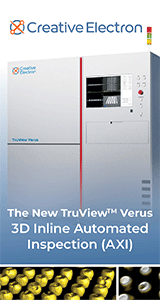|

|
|
|
|
Stencil Printing for Miniaturized Electronics
Production Floor |
|
Authored By:Chris Anglin Indium Corporation Clinton, New York TranscriptThe advent of miniaturized electronics for mobile phones and other portable devices has required the assembly of smaller and smaller components. Currently 01005 passives and 0.3 mm CSPs are some of the components that must be assembled to enable these portable electronic devices. It is widely accepted that about 65% of all end of the line defects occur in the stencil printing process. Thus it is critical that a precision stencil printing process be developed to support miniaturized electronic assembly. This paper is a summary of significant experimental data and process optimization techniques that were employed to establish a precision SMT printing process. The results indicate that the industry standard stencil aperture area ratio requirement of greater than 0.66 is an excellent rule of thumb. However, by optimizing printer setup with vacuum support, foilless clamps, squeegee edge guards etc. and assuring cleanliness and squeegee and stencil quality, you may be able to obtain acceptable stencil printing results with area ratios of 0.5 with Type III solder pastes. The work that was performed to achieve these results is discussed in detail in this paper. SummaryThe advent of miniaturized electronics for mobile phones and other portable devices has required the assembly of smaller and smaller components. Currently 01005 passives and 0.3 mm CSPs are some of the components that must be assembled to enable these portable electronic devices. It is widely accepted that about 65% of all end of the line defects occur in the stencil printing process. Given all of the above, it is critical that a precision stencil printing process be developed to support miniaturized electronic assembly. This paper is a summary of a significant amount of experimental data and process optimization techniques that were employed to establish a precision SMT printing process. Our results indicate that the industry standard stencil aperture area ratio requirement of > 0.66 is an excellent rule of thumb. However, by optimizing printer setup with vacuum support, foilless clamps, squeegee edge guards etc and assuring cleanliness and squeegee and stencil quality, we have been able to obtain acceptable stencil printing results with area ratios of 0.5 with Type III solder pastes. The work that was performed to achieve these results will be discussed in detail in the paper. ConclusionsThe evaluation of solder paste print products using the current standard printing process offers a quality assessment of these pastes and suggests improvement techniques for the tooling and process setup. Using statistically based analysis to characterize the stencil printing process demonstrates an approach for quantitatively benchmarking the current process. This approach provides a measure with which to contrast precision stencil printing processes and materials. This approach will be required for further miniaturization of electronic assembly products. Initially Published in the IPC Proceedings |
|
Comments
|
|
|
|

|


